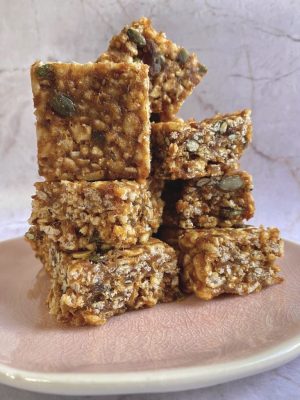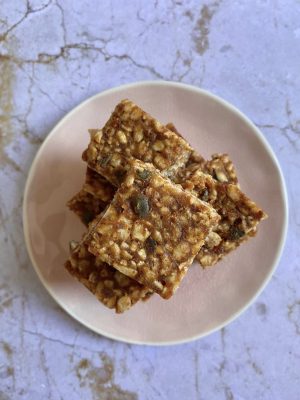
Toffee crisp bars are a classic chocolate bar in the UK. They are a finger of rice cereal mixed with chewy caramel, coated in milk chocolate. This recipe is in ode to this sweet-shop staple. Absolutely all foods in moderation are fine and make up part of a healthy diet so we don’t need to banish the toffee crisps from the cupboard. But, when you are looking for a more everyday snack or treat to fuel energy slumps or chuck in the kids lunchboxes these are a great alternative, that will keep you fuller and more energised for longer, and go towards one of your five a day.
Honestly, these are so indulgent. Dates are natures natural caramel and when mixed with creamy nut butter they become ultra fudgey. This richness works perfectly with the airy crunch of the cereal. My secret hack in the methods ensures the rice cereal will stay crisp all week long (if you can make them last that long!). This recipe requires just 3 ingredients but I’ve suggested some great add ins if you really want to pimp these up. Also feel free to dunk them in chocolate, too really replicate a toffee crisp.


Now lets get into the foodie facts! (Nah just give me the recipe)
Dates are high in sugars averaging around 63g of carbohydrates per 100g of fruit. All the carbohydrate in dates is sugars; glucose and fructose1. Before you start worrying about the high sugar content, spiked blood sugar levels and hyper kids. Unlike the toffee crisp bars dates are also high in fibre, about 4g per 100g1. When you eat the whole date, you are also eating the fibre which helps slow digestion of sugars, meaning the energy from the sugar will be released over a longer period, reducing chances of a spike in blood sugar. Meaning you’ll feel satiated and more energised for a longer period of time1. Whereas, a toffee crisp bar contains negligible fibre as it is made with refined sugars that have had the fibre removed, meaning there is nothing to regulate the digestion of the sugar in the chocolate bar, more likely leading to a blood sugar spike2.
To give the fudge texture, the dates are blended with nut/seed butter. I like to use peanut butter as it gives a Snicker’s like dimension to the recipe, another indespensible chocolate bar!! Nuts and seeds are great sources of protein and eating a source of protein alongside sugar further helps slow the release of sugars into the blood stream1. Peanuts provide the highest quantity of protein per 100g of all commonly consumed nuts3. Now, I hear you shouting, “they are also high in fat!”. Yes nuts & seeds do conatin fat, but, like most macro nutrients (carbs, fats & protein) it is not black and white.Fats are essential within the body. For example, to make the lining of all our cells and synthesize hormones4, so we need to be consuming fats everyday in healthy amounts (about 70g for adult women and 95g for adult men)4. Unsaturated fats are better utilised by the body and less likely to raise your cholesterol4, compared to saturated fats (found in animal products and some hydrogenated, processed, plant-based foods)4. Nuts and seeds contain unsaturated fats and/or omega’s. For example, peanuts are high in mono-unsaturated fats3.
Nuts, seeds and dates are also a great source of micronutrients and bioactive compounds too. Dates contain calcium, Vitamin K and magnesium all of which help maintain healthy bones1. They are also high in antioxidants to counteract tissue damage from toxins1. Finally, they are a great source of the B vitamin folate, required for healthy red blood cells1. Pregnant women often lack folate so dates can be a great way to up levels1.
Now if my foodie facts haven’t persuaded you, hopefully the indulgent description has got you itching to whip up these snacks. Just 3 ingredients & the quickest method. You can enjoy these in no time!
(Cuts into 12 bars or 16 squares)
INGREDIENTS:
300g dried pitted dates/ medjool dates
150g peanut butter (spreadable is best, I use Sunpat ‘no sugar’)
115g puffed rice cereal (add 10g more if don’t use add ins)
optional add ins 35-50g toasted nuts/seeds or dried banana chips
METHODS:
1. Place your pitted dates in a bowl and submerge in boiling water. Put a plate on top and leave to steam and soften for 10 minutes. Drain the dates using a sieve or colander and squeeze out the excess water, either using your hands or, as they may still be very hot, using a tablespoon to squish the dates against the side of the sieve. If you are using medjool dates you can skip this step as they are naturally really soft and squidgy.
2. Add the dates and nut/seed butter to a food processor and blitz into a smooth, uniform paste. You will need to scrape down the sides several times to help it blend evenly. Avoid adding water as too much moisture will soften the rice cereal later and the squares won’t be crispy. This should take 2-3 minutes.
3. Spoon the paste into a large, microwavable bowl. Microwave the paste on high for 1 minute. This helps draw out any excess moisture so the treats stay crisp.
4. Fold through the cereal and optional add ins, until everything is evenly coated ini the date paste. Be gentle as not to break up the cereal.
5. Spoon into a 7″ square or 8″ circle tin, lined with parchment paper. Use the back of a spoon to tightly compress the mixture into an even layer. Leave to cool completely to room temperature and then place in the fridge for 2 hours to set. Slice into bars or squares and store in an airtight container. They will last for 5-7 days at room temperature, or in the fridge.
FOODIE FACTS RESOURCES:
1. BBC GOOD FOOD (Feb 2020) The health benefits of dates. Available at; The health benefits of dates – BBC Good Food
2. The Food Medic (Aug 2018) Natural vs. artificial sugars. Available at; Natural vs. artificial sugars | The Food Medic
3. J. Davis & L. Dean (2016) Peanuts Genetic Processing and Utilization Elsevier (pgs 289-345) Available at; Peanut Composition, Flavor and Nutrition – ScienceDirect
4. British Nutrition Foundation (July 2012) Fat. Available at; Fat – British Nutrition Foundation – Page #2

